
An electrical telegraph is a point-to-point text messaging system, primarily used from the 1840s until the mid 20th century when it was slowly replaced by other telecommunication systems. It used coded pulses of electric current through dedicated wires to transmit information over long distances. It was the first electrical telecommunications system, the most widely used of a number of early messaging systems called telegraphs, devised to send text messages more rapidly than written messages could be sent. This system allowed for communication to occur without the necessity of physical transportation. Prior to the electric telegraph, semaphore systems were used, including beacons, smoke signals, flag semaphore, and optical telegraphs for visual signals to communicate over distances of land.

Morse code is a method used in telecommunication to encode text characters as standardized sequences of two different signal durations, called dots and dashes, or dits and dahs. Morse code is named after Samuel Morse, one of the inventors of the telegraph.

A telephone is a telecommunications device that permits two or more users to conduct a conversation when they are too far apart to be heard directly. A telephone converts sound, typically and most efficiently the human voice, into electronic signals that are transmitted via cables and other communication channels to another telephone which reproduces the sound to the receiving user. The term is derived from Greek: τῆλε and φωνή, together meaning distant voice. A common short form of the term is phone, which came into use almost immediately after the first patent was issued.
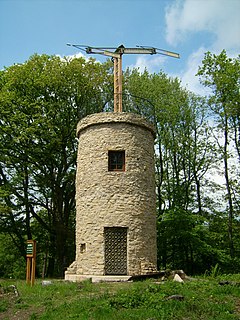
Telegraphy is the long-distance transmission of textual messages where the sender uses a system, known to the recipient, rather than a physical exchange of an object bearing the message. Thus flag semaphore is a method of telegraphy, whereas pigeon post is not. Ancient signalling systems, although sometimes quite extensive and sophisticated as in China, were generally not capable of transmitting arbitrary text messages. Possible messages were fixed and predetermined and such systems are thus not true telegraphs.

Wireless telegraphy or radiotelegraphy is transmission of telegraph signals by radio waves. Before about 1910, the term wireless telegraphy was also used for other experimental technologies for transmitting telegraph signals without wires. In radiotelegraphy, information is transmitted by pulses of radio waves of two different lengths called "dots" and "dashes", which spell out text messages, usually in Morse code. In a manual system, the sending operator taps on a switch called a telegraph key which turns the transmitter on and off, producing the pulses of radio waves. At the receiver the pulses are audible in the receiver's speaker as beeps, which are translated back to text by an operator who knows Morse code.
Timeline of electromagnetism and classical optics lists, within the history of electromagnetism, the associated theories, technology, and events.
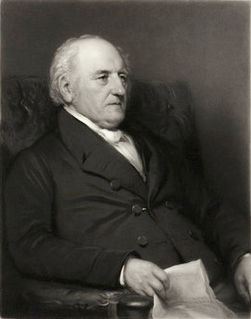
Peter Barlow was an English mathematician and physicist.
A telegraph code is one of the character encodings used to transmit information by telegraphy. Morse code is the best-known such code. Telegraphy usually refers to the electrical telegraph, but telegraph systems using the optical telegraph were in use before that. A code consists of a number of code points, each corresponding to a letter of the alphabet, a numeral, or some other character. In codes intended for machines rather than humans, code points for control characters, such as carriage return, are required to control the operation of the mechanism. Each code point is made up of a number of elements arranged in a unique way for that character. There are usually two types of element, but more element types were employed in some codes not intended for machines. For instance, American Morse code had about five elements, rather than the two of International Morse Code.
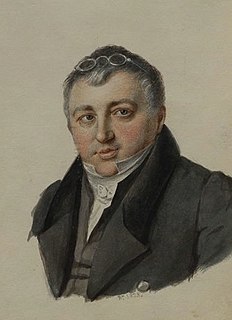
Baron Pavel Lvovitch Schilling (1786–1837), also known as Paul Schilling, was a Russian military officer and diplomat of Baltic German origin. The majority of his career was spent working for the imperial Russian Ministry of Foreign Affairs as a language officer at the Russian embassy in Munich. As a military officer, he took part in the War of the Sixth Coalition against Napoleon. In his later career, he was transferred to the Asian department of the ministry and undertook a tour of Mongolia to collect ancient manuscripts.

The invention of the telephone was the culmination of work done by many individuals, and led to an array of lawsuits relating to the patent claims of several individuals and numerous companies.
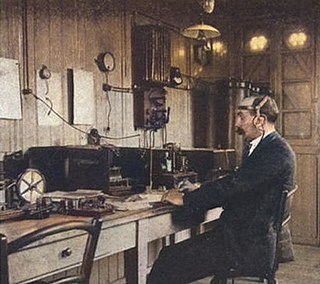
The invention of radio communication spanned many decades of experimental investigation of radio waves, establishment of theoretical underpinnings, engineering and technical developments, and adaptation to signaling. The work of many scientists culminated in the building of an engineering complete and commercially successful wireless communication system by Guglielmo Marconi, who is usually credited as the inventor of radio.
The timeline of radio lists within the history of radio, the technology and events that produced instruments that use radio waves and activities that people undertook. Later, the history is dominated by programming and contents, which is closer to general history.

The Signal Corps in the American Civil War comprised two organizations: the U.S. Army Signal Corps, which began with the appointment of Major Albert J. Myer as its first signal officer just before the war and remains an entity to this day, and the Confederate States Army Signal Corps, a much smaller group of officers and men, using similar organizations and techniques as their Union opponents. Both accomplished tactical and strategic communications for the warring armies, including electromagnetic telegraphy and aerial telegraphy. Although both services had an implicit mission of battlefield observation, intelligence gathering, and artillery fire direction from their elevated signal stations, the Confederate Signal Corps also included an explicit espionage function.
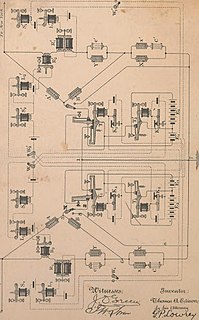
The Quadruplex telegraph is a type of electrical telegraph which allows a total of four separate signals to be transmitted and received on a single wire at the same time. Quadruplex telegraphy thus implements a form of multiplexing.
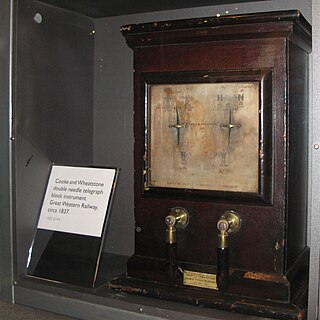
The Cooke and Wheatstone telegraph was an early electrical telegraph system dating from the 1830s invented by English inventor William Fothergill Cooke and English scientist Charles Wheatstone. It was a form of needle telegraph, and the first telegraph system to be put into commercial service. The receiver consisted of a number of needles which could be moved by electromagnetic coils to point to letters on a board. This feature was liked by early users who were unwilling to learn codes, and employers who did not want to invest in staff training.
Charles Ernest Spagnoletti MInstCE, MIEE was an electrical inventor and the first telegraph superintendent of the Great Western Railway (GWR). He also advised various railway companies on the use of electricity, signalling, and telegraphy.

A needle telegraph is an electrical telegraph that uses indicating needles moved electromagnetically as its means of displaying messages. It is one of the two main types of electromagnetic telegraph, the other being the armature system as exemplified by the telegraph of Samuel Morse in the United States. Needle telegraphs were widely used in Europe and the British Empire during the nineteenth century.

The British and Irish Magnetic Telegraph Company was founded by John Brett in 1850. The Magnetic was the principal competitor to the largest telegraph company in the United Kingdom, the Electric Telegraph Company. The Magnetic was the leading company in Ireland, while the Electric was the leading company in mainland Britain. Between them, they dominated the market until the telegraph was nationalised in 1870.

The Foy–Breguet telegraph, also called the French telegraph, was an electrical telegraph of the needle telegraph type developed by Louis-François-Clement Breguet and Alphonse Foy in the 1840s for use in France. The system used two-needle instruments that presented a display using the same code as that on the optical telegraph of Claude Chappe. The Chappe telegraph was extensively used in France by the government, so this arrangement was appealing to them as it meant there was no need to retrain operators.

Earth-return telegraph is the system whereby the return path for the electric current of a telegraph circuit is provided by connection to the earth through an earth electrode. Using earth return saves a great deal of money on installation costs since it halves the amount of wire that is required, with a corresponding saving on the labour required to string it. The benefits of doing this were not immediately noticed by telegraph pioneers, but it rapidly became the norm after the first earth-return telegraph was put into service by Carl August von Steinheil in 1838.

















